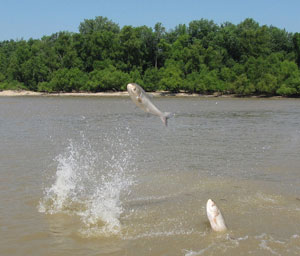Time to let science drive Great Lakes policy on Asian carp
The threat that Asian carp pose to the Great Lakes community may be politically controversial.
 The threat that Asian carp pose to the Great Lakes community may be politically controversial, but it’s time to stop wringing hands over established facts and let science drive policy and put knowledge into action, says an MSU AgBioResearch fisheries expert.
The threat that Asian carp pose to the Great Lakes community may be politically controversial, but it’s time to stop wringing hands over established facts and let science drive policy and put knowledge into action, says an MSU AgBioResearch fisheries expert.
“You know it’s big when academics and the management community say we don’t need five more years of study,” said Bill Taylor, university distinguished professor in global fisheries sustainability at MSU and a member of MSU’s Center for Systems Integration and Sustainability. “The costs of hydrological separation are high, but it’s a one-time expense, and remediation in the Great Lakes from these invasive species will eventually make separation look cheap.”
Taylor is one of four Great Lakes and Mississippi River researchers publishing a paper that breaks down four recent assertions that downplay the threat of the invasive Asian carp and questions the need to investigate ways to physically separate the Great Lakes and Mississippi River basins to prevent the further spread of harmful non-native species.
The research was published in The Journal of Great Lakes Research. Authors are Taylor; Jerry Rasmussen, of Natural Resource Management Associates; Henry Regier, University of Toronto; and Richard Sparks, a senior scientist at the National Great Rivers Research and Education Center.
The authors conclude that the threats posed by the Asian carp and other invasive species remain high and warrant action to prevent further ecological and economic harm to the Great Lakes ecosystem.
The paper examines recent claims by policy-makers that:
- Existing electric barriers are effective in preventing the spread of the Asian carp.
- It is too late to prevent an Asian carp invasion.
- Asian carp will not thrive in the Great Lakes.
- Asian carp are not likely to cause serious damage to the Great Lakes.
Implications that more study is needed are exasperating the science community, Taylor said. Science has done its job by reaching thoughtful and clear conclusions. Now, he said, is a time for action – or at the least a clear decision not to take action.
“I am tired of studying what we already know is going to happen,” Taylor said. “We’ve watched this coming on for 10 years. We know what’s going to happen.”
Taylor said science clearly points to the likelihood that invasive Asian carp, which are voracious feeders, will prove to be highly effective food competitors to native fish species. It’s not the vast open areas of the Great Lakes he sees as threatened but rather the lakes’ near-shore areas, wetlands and tributaries – rivers that now serve as rich habitat for diverse and highly productive fish communities, including our economically important game fish.
“The Asian carp are going to whack the tributaries,” Taylor said. “They’re going to eat all the food – they eat anything they get in their mouths, and that means they’ll eat the food base that our resident fish would normally eat. They will change the food web and dominate our streams and near-shore regions in the Great Lakes basin.”
Congress, the paper says, can play an important role in addressing the invasive species problem by passing legislation mandating the U.S. Army Corps of Engineers to complete a study that offers a permanent solution based on the best scientific information and engineering technology available.



 Print
Print Email
Email




